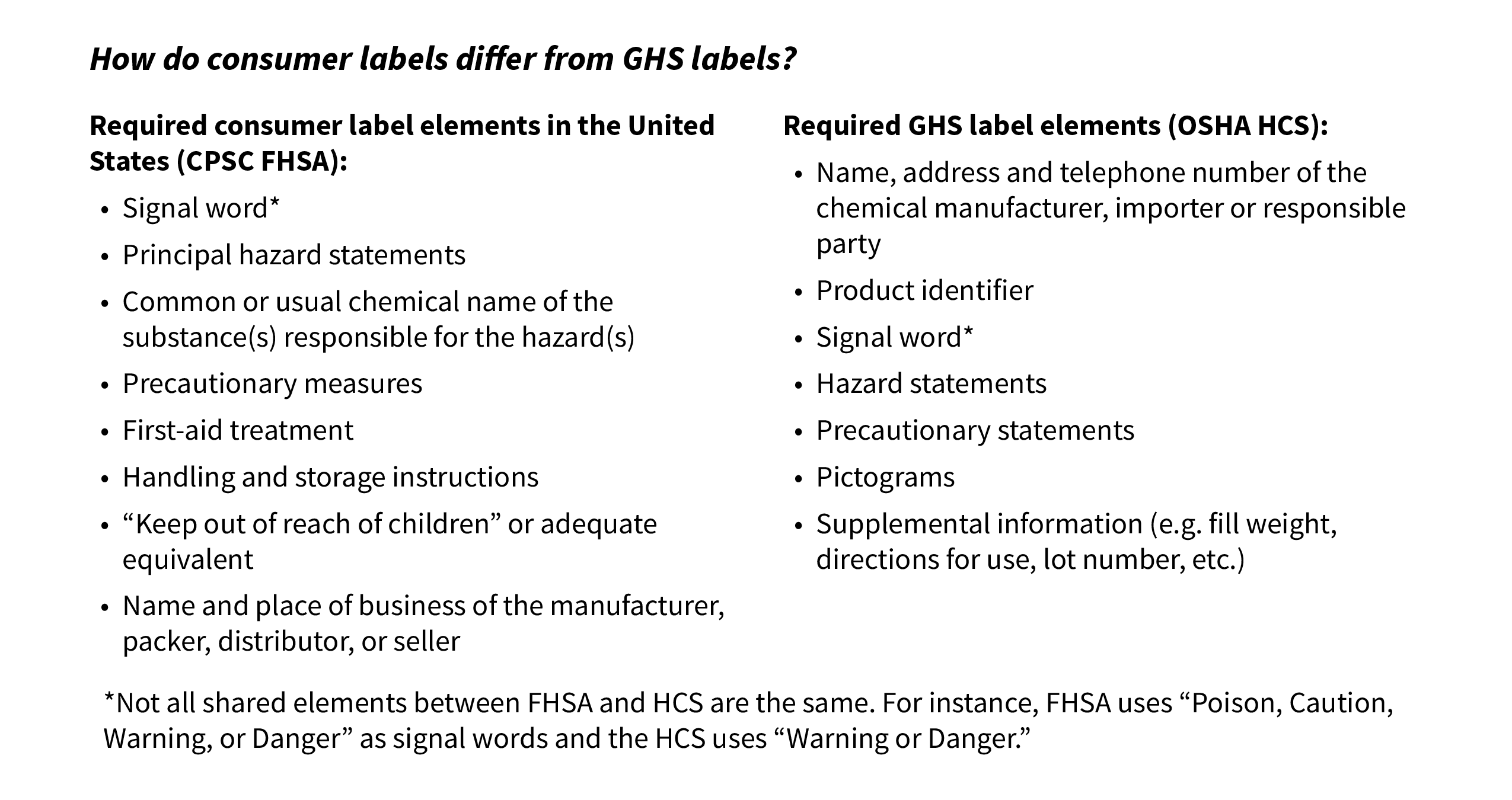U.S. Consumer Chemical Labels: How do they Differ from GHS Labels?
U.S. Consumer Chemical Labels: How do they Differ from GHS Labels?
While GHS Labels and Consumer Chemical Labels are not unique to the U.S. market, for comparison purposes we will be focusing on the Occupational Safety and Health Administration (OSHA) GHS Label vs U.S. Consumer label. Although both are important in the chemical industry, each serves a different purpose and cannot be used interchangeably. To understand if a product requires a consumer label or not, the manufacturer/supplier must first determine if the product is intended for consumer use.
What is a consumer product?
A consumer product is a finished, manufactured good purchased by an individual or household for personal use. It is not intended to be for further production or resale. Consumer chemical products may include general cleaning products, detergents, paints, adhesives, and air fresheners.
The US Consumer Product Safety Commission (CPSC) administers the Federal Hazardous Substances Act (FHSA) which determines the precautionary labeling on the container of hazardous household products to help consumers safely store and use those products and to give them information about immediate first aid steps to take if an accident happens.
Consumer products labeling regulations do not cover products registered with other government agencies (such as FDA and EPA) including cosmetics, drugs, pesticides, or food.
What is GHS labeling?
OSHA has adopted the Globally Harmonized System of Classification and Labeling (GHS) and determines the required labeling for hazardous chemicals in the workplace. The GHS was developed by the United Nations and established rules for classifying the hazards of chemical products, a format for safety data sheets (SDS), and content for labels and SDS with hazard and precautionary statements, symbols, and signal word requirements.
OSHA’s labeling regulations are detailed in the Hazard Communication Standard (HCS). For more information on the HCS labels, check out CHEMTREC’s latest post on HCS label updates.
Why is consumer chemical labeling different from workplace chemical labeling (i.e. GHS)?
The scopes and purposes of the HCS and FHSA are different. The HCS focuses on workplace safety and ensuring workers are properly informed about the hazards of the chemicals they use. The FHSA focuses on household and consumer products and allows consumers to be informed about the hazards and proper usage of the products they purchase.
Consumer labeling specifically addresses the use of a product by a consumer in the household. The precautionary labeling for consumer regulations helps consumers safely use and store the product and provides information about first aid if an accident does occur. For example, the statement “Keep out of reach or children” is required to be displayed on hazardous consumer products, whereas this statement is not commonly used on GHS labels in the workplace where children are not likely to be present.

What chemicals are considered hazardous?
FHSA defines a hazardous substance as any substance or mixture of substances which is classified in one or more categories below and may cause substantial personal injury or illness during customary or reasonably foreseeable handling or use (including ingestion by children).
- Toxic
- Corrosive
- Irritant
- Strong sensitizer
- Flammable or combustible
- Generates pressure through decomposition, heat or other means
The HCS defines a hazardous chemical as any chemical which is classified as a physical hazard or a health hazard, a simple asphyxiant, combustible dust, or hazard not otherwise classified.
OSHA hazard categories include but are not limited to:
- Flammable
- Pressurized chemicals and gases including aerosols
- Oxidizer
- Explosive
- Corrosive
- Irritant
- Acutely toxic
- Carcinogens
- Mutagens
- Reproductive toxicants
Similarly to the label elements, not all shared hazard categories between the FHSA and the HCS are aligned.
For more information on FHSA and HCS labeling see:
CPSC Federal Hazardous Substances Act
OSHA Hazard Communication Standard
What if consumer products are used in the workplace?
Hazardous consumer products are often used in the workplace such as cleaning products. According to OSHA, if the employee use of consumer products is of greater frequency and duration than normal consumer use, the requirements of HCS apply. It is the employer’s responsibility to assess his workers’ exposures and determine if and when the requirements of HCS apply. Where an employer is uncertain whether the duration and frequency of exposure to these products is comparable to that of a consumer, they should obtain and/or develop a Safety Data Sheet and GHS label and make it available to employees.
Have questions about consumer or GHS labeling?
CHEMTREC is dedicated to helping you meet all your labeling requirements to keep your workforce and customers safe. Whether you need GHS labels for workplace or labels for consumer products, our expert team is here to support you in understanding and implementing the necessary labeling standards.
For your labeling needs, contact CHEMTREC today!
Request A Quote
Interested in learning more? Get an estimate for CHEMTREC services.